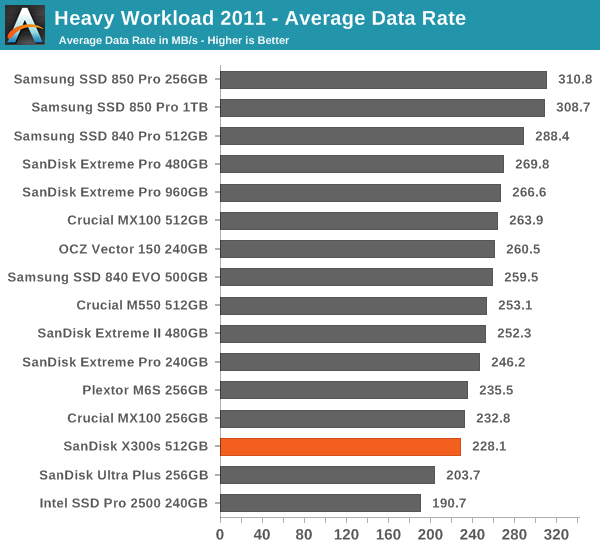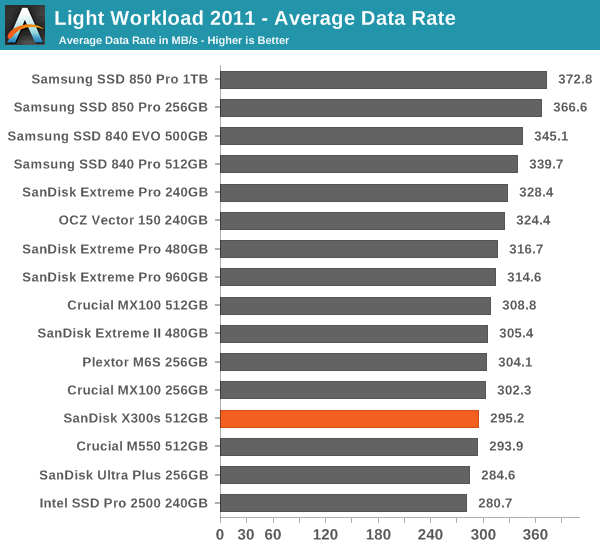SanDisk X300s (512GB) Review
by Kristian Vättö on August 21, 2014 2:15 PM ESTAnandTech Storage Bench 2011
Back in 2011 (which seems like so long ago now!), we introduced our AnandTech Storage Bench, a suite of benchmarks that took traces of real OS/application usage and played them back in a repeatable manner. The MOASB, officially called AnandTech Storage Bench 2011 – Heavy Workload, mainly focuses on peak IO performance and basic garbage collection routines. There is a lot of downloading and application installing that happens during the course of this test. Our thinking was that it's during application installs, file copies, downloading and multitasking with all of this that you can really notice performance differences between drives. The full description of the Heavy test can be found here, while the Light workload details are here.

The X300s does not perform that well in our 2011 Storage Benches. I would say that the 2011 Benches, especially the Light suite, are closer to a typical corporate workload with lots of email and office use, so I would give more value to that instead of the 2013 Bench. The X300s is still okay in both 2011 Benches and better than the Intel SSD Pro 2500, but I was expecting a bit more given the performance of the Extreme Pro and Extreme II.











34 Comments
View All Comments
Kristian Vättö - Friday, August 22, 2014 - link
That is not true. Windows 7 is still the dominant OS in the enterprise space with Windows 8 only having a marginal share:http://www.sysaid.com/company/press/382-global-win...
Yes, that is one-year-old data but it shows that enterprises are not very keen on W8 and are adopting it very slowly. That in turn leaves a huge market for solutions like Wave ECS since the BitLocker in Windows 7 does not support Opal.
Besides, eDrive/BitLocker is the same for every drive. I don't see the need to revisit it with this drive because the process is not any different.
cbf - Friday, August 22, 2014 - link
Well, that market share article is from June 2013.While, I don't think Windows 8.1 is taking the market by storm, I think it is creeping in. I've deployed it due to things like improved startup/hibernation, BitLocker improvements, etc. The start menu just isn't that big a deal for my users.
In any event, it looks like we'll see Win 9 in the next six months, which I predict enterprises will deploy as fast as they've ever deployed any new Windows OS, so that should settle the issue.
jabber - Saturday, August 23, 2014 - link
Maybe not.Windows 9 is too soon. A lot of corps are only two years into their OS refresh, they aren't going to change till maybe 2017 at the earliest and then 10 is round the corner. A lot haven't moved to 7 till this year so they are going to hang around till 2020. Windows 10 will be the one that fits the schedule better.
9 will bomb probably. Plus anyone knows that 9 is purely a rushed damage limitation excercise.
devione - Thursday, August 21, 2014 - link
Hi Kristian,Really appreciate your efforts. However would it be possible to see future reviews involving Enterprise-grade SSDs? Thanks for your time.
Kristian Vättö - Friday, August 22, 2014 - link
Yeah, we have something in the works :)jay401 - Friday, August 22, 2014 - link
By the way, the Samsung 840 Evo in 256GB and 512GB sizes just dropped $20 and $50 in price on Amazon. $119 and $199 respectively, though the 500GB did just bump back up slightly to $212.7amood - Friday, August 22, 2014 - link
I appreciate the SEDs but I think these aren't open source and can't be audited like TC which is being audited right now. How to know for sure that the SED encryption is secure and doesn't have backdoor code for the spying?fk- - Saturday, August 23, 2014 - link
I'm still a bit confused about one thing - with all that security software listed in the table, what are the motherboard requirements to use the encryption on this drive? Do I still need a motherboard capable of setting ATA password if I want to password-protect the data on the drive?Or, to put it straight, is there any [software] way to use the option to password-protect the drive (and being prompted to enter the password on startup) on an older motherboard without UEFI, without ATA password capabilities and without Opal certification?
Kristian Vättö - Sunday, August 24, 2014 - link
Wave's ECS should do that as long as the drive is Opal certified. I tested without UEFI and it worked fine, and ATA password is just a BIOS feature whereas Opal is independent from the rest of the system (i.e. should work with any motherboard or system).mike8675309 - Sunday, August 24, 2014 - link
I assume that when you use the took to secure erase that when you enter the PSID that the drive is no deactivating the encryption, and then secure erasing the drive. Using that tool and that process must do something more complex so that avoids creating an attack vector.